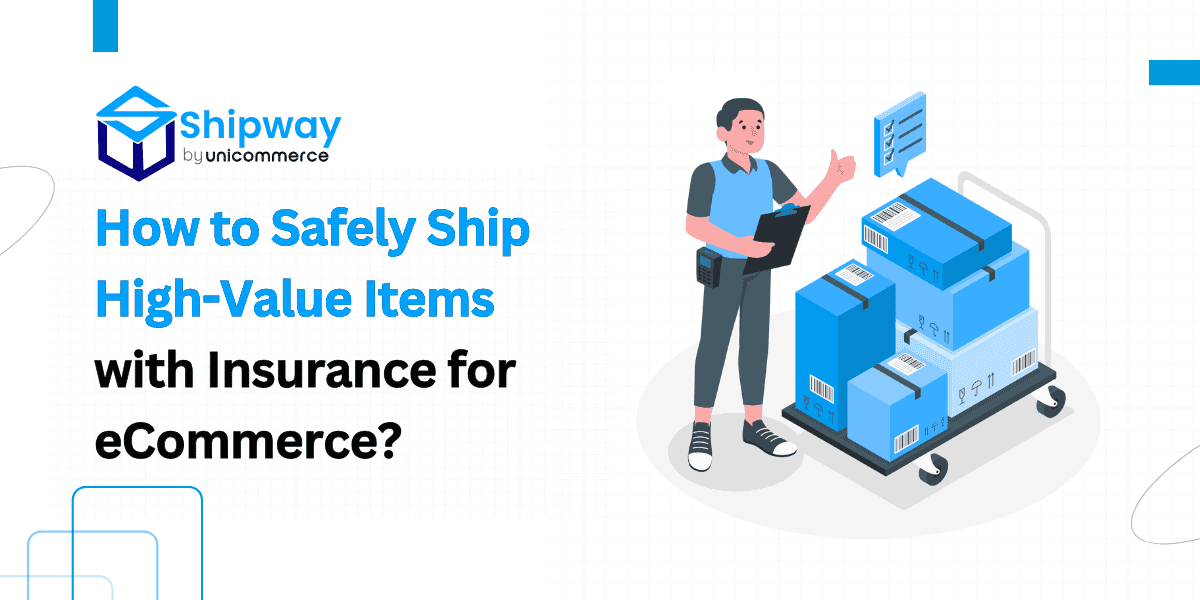Imagine you’re running an online store, selling delicate gift baskets or handcrafted jewelry. When you ship these items to your customers, there’s a chance something might go wrong, like the package getting lost, damaged, or even stolen on the way. This is where shipping insurance comes in.
Shipping insurance in ecommerce is a solution to protect the packages during their movement (i.e., from the seller to the buyer). It’s like buying a safety net for your packages, so you don’t lose money if something bad happens during delivery.
This coverage pays for losses that are primarily caused by damage, misplacement, or theft that may occur along the way. It is a useful tool for online sellers who ship products over long distances. This proves helpful when the goods travel far or even internationally, as the possibility of damage/loss increases. Sellers can avoid bearing all costs when a mishap happens with the help of shipping insurance.
This article explains what shipping insurance is, describes its benefits, outlines different policy types, and presents guidance on handling claims. The article also provides some helpful practical advice for ecommerce businesses and explains how shipping insurance affects customer satisfaction and reputation.
What is Shipping Insurance?
Shipping insurance is a policy purchased by sellers or buyers. It provides financial protection for packages in transit. Some of its basic features are:
- Coverage Scope: The policy covers sellers from damage, loss, or theft during transport. Specific details are laid out in the policy document. For example, if you sell a custom-made ceramic mug and it cracks during shipping, the insurance can help cover the cost of a replacement.
- Claim Amount: The insurance may cover the full replacement cost or a small portion of the loss. Some policies pay for repairs or provide some sort of reimbursement up to a preset limit. For instance, if you insured a $100 product, you might get the full $100 back or just a part, depending on the plan.
- Eligibility: The policy often requires that the seller meet all conditions set by the insurer. For example, proper packaging and prompt claim submission are usually necessary. If you sent a laptop without proper padding and it got smashed, the insurer might reject your claim because of poor packaging.
- Policy Conditions: The insurer will list the events covered. The seller must review these conditions carefully to know what is and is not protected.
Why Do Online Sellers Need Shipping Insurance?
Online sellers face risks when shipping their products. Shipping insurance provides several benefits that help maintain business stability.
Think about it like this: if you’re sending a fragile glass vase or an expensive smartwatch, you want to be sure you won’t lose all that money if the package breaks or disappears. Shipping insurance helps you recover some or all of the money you might lose in such situations. Not just this, shipping insurance also provides you with other benefits like
1. Financial Protection
If a package goes missing or arrives broken, you can file a claim and get some or all of the money back.
Example: Imagine you sell custom headphones worth $1000. If the package gets lost in transit, the insurance can cover the cost, so you don’t have to take the full hit.
2. Building Customer Confidence
When buyers know their orders are insured, they feel safer shopping with you. This can lead to better reviews and more repeat orders.
Example: If a customer buys a fragile glass vase and knows it’s covered, they’re more likely to shop with you again, even if something goes wrong.
3. Quick Problem Resolution
If a package is lost or damaged, you can quickly resolve the issue by filing a claim, keeping your customers happy.
Example: If a buyer receives a cracked phone case, you can send them a replacement without losing money, thanks to insurance.
4. Cost Control
It helps you avoid unexpected expenses and protects your profit margins.
Example: If you sell a $500 smartwatch, a small insurance fee is worth it if it means you don’t have to replace it out of pocket if it gets lost.
5. Extra Peace of Mind for High-Value Items
For expensive items like electronics, jewelry, or designer clothes, insurance provides confidence when shipping.
Example: If you sell a high-end camera or ship laptops internationally, insurance can cover a big chunk of the cost if it’s damaged or stolen.
6. Better Customer Trust
When you clearly communicate your shipping policies and offer insurance, customers are more likely to trust your store.
Example: If your store advertises “fully insured shipping,” it can make customers feel more secure about their purchase.
Different Types of Shipping Insurance Policies for eCommerce
There are several policy options for online sellers. The type of shipping policy chosen depends on the seller’s needs and the nature of the goods shipped. Consider the following examples:
1. Carrier-Provided Insurance
- Basic Coverage: Many shipping companies in India offer basic insurance as part of their service package. The cost may be included in the shipping fee. The limits of this coverage might be low for high-value items.
- Example: If you ship with a major carrier like BlueDart, FedEx or DTDC, they might already cover small packages up to a certain amount.
2. Third-Party Insurance Policies
- Extended Protection: Third-party insurers provide policies designed for online sellers. These policies may cover a wider range of incidents. They can provide options that pay the full replacement cost.
- Example: If you sell high-value electronics, a third-party policy might offer better coverage than what the regular courier provides.
3. Specialized Policies
These include:
- Fragile Items: Policies for items that are broken might cover breakage from mishandling.
- High-Value Goods: Policies that provide higher claim limits and different deductibles.
- Pre-Shipping Coverage: In some cases, damage occurs during the packaging process.
When choosing a policy, you need to consider the below
- The nature of the items they ship.
- The value of those items.
- The shipping routes and methods they use.
How Shipping Insurance Works?
A contract is formed between the seller and the insurer at the time when the seller purchases shipping insurance. The following steps explain the process when an issue occurs:
- Understanding Your Policy
- Before you start shipping, you need to know what your insurance covers.
- Example: If you sell fragile ceramics, you’ll want a policy that covers breakage, not just lost packages.
- Keeping Records
- You’ll need to keep all the important details, like tracking numbers, photos of the packed items, and invoices. This paperwork helps prove your claim if something goes wrong.
- Example: If you’re sending a $200 smartwatch, take a picture of the well-packed box before shipping.
- When Something Goes Wrong
- If a package gets lost, stolen, or damaged during shipping, you gather all the evidence to support your claim.
- Example: If a customer says their Bluetooth speaker arrived cracked, you’ll need the original packing photos, the customer’s complaint, and the shipping receipt to file a claim.
- Filing the Claim
- You fill out a claim form, attach the evidence, and send it to the insurer.
- Example: If a package worth $150 goes missing, you file a claim with the shipping insurance company, including the tracking number and purchase receipt.
- Claim Processing
- The insurance company reviews your documents. If everything checks out, they approve the payout.
- Example: If you followed all the packaging guidelines and submitted the right documents, you should get your money back quickly.
- Deductibles
- Some policies require you to pay a fixed amount before the insurer covers the rest.
- Example: If your policy has a $20 deductible and you’re claiming a $200 item, the insurer might only pay you $180.
Following these steps helps in making the claim process smoother and may result in faster reimbursement on time.
How to Compare Shipping Insurance Providers for the Best Coverage?
1. Research Different Providers
Look up companies that offer shipping insurance and check their websites for policy details.
Example: Compare a major carrier’s insurance to a third-party provider to see which one fits your needs better.
2. Check What They Cover
Make sure the policy covers the types of products you sell and the problems you’re most worried about.
Example: If you sell electronics, you might want a policy that covers high-value items without strict exclusions.
3. Read Customer Reviews
Find out what other sellers say about the company’s claims process and customer service.
Example: A provider with quick, hassle-free claims might be better, even if it costs a bit more.
4. Get Multiple Quotes
Request quotes from different providers to compare prices and coverage.
Example: One company might charge 2% of the item’s value, while another has a flat $5 fee per package.
5. Look for Extra Support
Some companies offer dedicated support or online claim tracking, which can make the process easier.
A careful comparison will help in selecting a shipping insurance provider that meets both financial and coverage needs.
How to Find the Best Shipping Insurance Rates for eCommerce?
Sellers should consider these aspects when planning their shipping expenses:
- Value of the Item: More expensive items incur higher premiums.
- Shipping Method: International shipping or same day delivery options usually involve higher fees.
- Calculation Methods: Some insurers calculate premiums as a percentage of the shipment value, while others charge a flat fee per package.
- Frequency of Shipments: Sellers who send many packages may be eligible for discounts.
- Claim History: A record with few claims can lead to lower premiums in the future.
What Challenges Do Online Sellers Face with Shipping Insurance?
- Policy Limitations: Some policies have restrictions that might not cover all types of damage or loss.
- Cost Factors: For small businesses, the added expense might be difficult to manage, especially if shipments are frequent.
- Claim Processing Time: Completing the claim process may require time and attention. This can further take away from day-to-day operations.
- Documentation Requirements: A claim often requires detailed documentation. This means sellers must maintain precise records.
- Exclusions: Some policies do not cover incidents caused by improper packaging or handling errors from the seller’s end.
To fix these challenges, sellers can implement the below:-
- Before purchasing, review the policy details carefully.
- Make sure to use proper packaging to reduce claim denial risk.
- Set aside time for proper record-keeping and claim processing.
- Choose a provider known for a simple claim process.
Wrapping Up
Shipping insurance is like a safety net for online businesses, especially if you sell expensive items. It helps you avoid losing money if a package gets lost, broken, or stolen during delivery. Plus, it shows your customers that you care about their orders, which can make them trust you more. By picking the right insurance, packing items well, and being ready to handle claims, you can protect your business and keep your customers happy.


